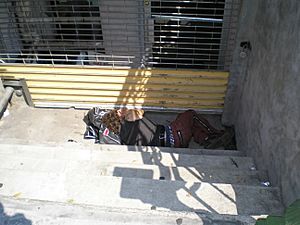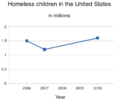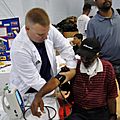Homelessness facts for kids
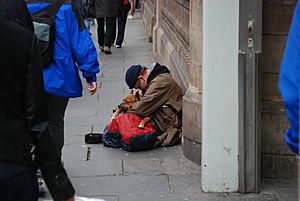
Homelessness means not having a safe and stable place to live. It includes people who sleep in warming centers, homeless shelters, or places not meant for living, like abandoned buildings or streets. Homelessness happens for many reasons. Often, it's because people cannot afford or keep a home. Many countries believe that having a home is a basic right to housing.
Contents
Understanding Homelessness
People who do not have a home are often called "homeless people." Sometimes, other words are used, but these might not always be correct. For example, a "vagabond" is someone who travels without much money. They might or might not have a home somewhere else. Police sometimes use the word "transient" for people just passing through a town. These words can be confusing because someone passing through might have a home or not.
It can be hard to count how many people are homeless. But governments need to know this to help. In the USA, for example, the Housing and Urban Development (HUD) agency counts homeless people every two years. They have a special way to define "homeless." Many other groups use this same definition.
Why People Become Homeless
Many studies have looked at the main reasons why people become homeless. Here are some of the most common causes:
- Not enough affordable homes
- Jobs that do not pay enough money
- Difficulties with health and well-being, and not enough help for these issues
- Unsafe home situations
- Not having a job
- Feeling left out by society
- Being treated unfairly, which can lower a person's confidence
- Not having enough money (poverty)
- Returning to society after being away (like after being in a hospital or other institution)
- Changes in government support programs
- Big natural events like floods or storms
Health Challenges for Homeless People
Taking care of the health of homeless people is a big challenge. People living on the streets are more likely to get hurt or have health problems. For example, they might get skin problems from being in the sun without protection. It is also hard to find places to wash. They are exposed to very cold and hot weather.
Finding good food is also tough. This can lead to health issues. They might eat a lot of unhealthy food, which can cause problems like obesity. Dental problems are also common because it's hard to clean teeth and they might eat many sweets. Other common health issues include diabetes and liver problems.
Finding Help for Health
A tool called the vulnerability index helps find out which homeless people on the street need health care and housing the most. This index was created by Dr. Jim O'Connell in Boston. He wanted to understand why homeless people were dying on the streets.
Organizations like Common Ground are using this index during homeless counts. They believe that using it will help get people who need it most off the street and into homes. This index has been used in many places, not just on the East Coast of the USA.
History of Helping the Homeless
In England, in the 1500s, the government first tried to give homes to people who wandered without a place to stay. Before this, they were often punished. Later, in the 1700s, these homes were replaced by workhouses. These were places where poor people had to work. By the 1930s, about 30,000 people in England lived in these types of places.
In many cities around the world, there used to be areas where poor people and travelers lived. These were sometimes called "skid rows." In smaller towns, there were "hobos" who traveled by train and camped near the tracks. As more people became homeless, places like churches and libraries became stricter about people staying there for long periods.
In the 1980s in the United States, new laws were made to help homeless people. This was thanks to Congressman Stewart B. McKinney. In 1987, the McKinney-Vento Homeless Assistance Act became law. Many groups in cities like New York and Boston started new ways to help the growing number of homeless people.
Help and Support for Homeless People
Most countries offer different kinds of help for homeless people. This includes food, shelter, and clothes. These services are often run by community groups, volunteers, or government departments. They get support from governments, charities, churches, and individuals. However, not all homeless people can easily get this help.
Social Support
Homeless people often support each other. Also, people who are not homeless can offer friendship and help. This support can come from official groups like non-profit organizations or churches. It can also come from individuals helping others.
Finding Work and Income
Employment
The United States Department of Labor tries to help homeless people find jobs. They offer training programs and ways to get jobs that can help people live on their own. The United States Interagency Council on Homelessness works at a national level to connect homeless people with job resources. In theory, anyone needing help can get job training through programs like the Workforce Investment Act.
Other Ways to Earn Money
Homeless people can also earn money by collecting things to recycle. They might find bottles and cans to take to recycling centers. They can also sort trash or pick up litter to earn some money.
Street Newspapers
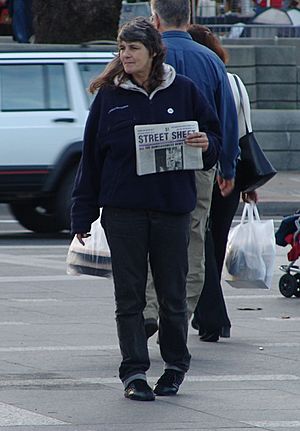
Street newspapers are special newspapers or magazines. Homeless or poor people sell them to earn money. These papers usually talk about homelessness and poverty. They help connect people in homeless communities and give homeless individuals a way to work.
Health Care Access
In the United States, a law passed in 2010, the Patient Protection and Affordable Care Act, helped create new health care options for homeless people. This was especially true through the expansion of Medicaid, a health care program.
In 1985, the Boston Health Care for the Homeless Program started. It helped homeless people in Boston who needed medical care. In 2008, they opened Jean Yawkey Place in Boston. This is a large building dedicated to providing full health care services for homeless people. It also has a long-term care facility, the Barbara McInnis House, which is the first and largest medical recovery program for homeless people in the United States.
In Los Angeles, a dental school and a shelter work together to offer free dental services to homeless people. Studies show that good mental health care can help homeless people find stable housing.
Housing Solutions
Providing permanent supportive housing (PSH) seems to help people experiencing homelessness find stable places to live for a long time.
Saving Money by Housing Homeless People
A study in Central Florida in 2013 found that it cost about $31,000 per year for each homeless person. This money was spent on things like police arrests, jail stays, and emergency room visits. In contrast, providing permanent supportive housing cost about $10,051 per person per year. The study concluded that housing even half of the long-term homeless population could save a lot of money over time. Similar studies in other cities have also shown big savings by focusing on simply housing homeless people.
New Ideas for Housing
In Los Angeles, Mayor Eric Garcetti held a competition for new ideas to build housing for homeless people more cheaply. Some winning ideas included using easy-to-assemble panels, pre-made stackable houses, and turning garages into small apartments for rent. Another idea was to fix up old "Bungalow-court" units, which were small, low-cost homes from the 1920s.
In the Westlake neighborhood of Los Angeles, a new building for homeless people is being made from old shipping containers. This "Cargotecture" building will have 84 containers stacked together like Lego bricks.
Political Action
Voting is important for homeless people to have their voices heard in government. Many groups around the world are working to reduce homelessness. They try to help homeless people become self-sufficient. These groups often start from the community level. They aim to change stereotypes about homeless people and make sure their voices are heard by leaders.
Organizing in Shelters
Homeless shelters can be places where people organize and join movements to help themselves. A representative from the homeless community in each shelter can work with the shelter staff. They can share problems, concerns, and new ideas. For example, they might discuss ways to help with health issues or solve arguments. SAND, a Danish organization for homeless people, uses this approach. They discuss issues from shelters at a regional or national level.
Help for Veterans

Many organizations support homeless veterans. This is a common issue in the United States. Groups help house veterans or send them to care facilities. The SOAR project helps eligible adults who are homeless or at risk of homelessness and have health challenges get financial support.
The United States Department of Housing and Urban Development and the Veterans Administration have a special housing program called HUD-VASH. It gives housing vouchers to eligible homeless veterans. This program has been successful in housing many veterans.
The Department of Labor also has programs to help veterans find jobs. The Homeless Veterans' Reintegration Program (HVRP) helps veterans get back into the workforce. There are also services specifically for female veterans.
Related pages
Images for kids
-
The Bowery Mission in New York City, United States, in the 1800s
-
A homeless man living in a sewer, Vienna, Austria, circa 1900
-
Food line at the Yonge Street Mission, 381 Yonge Street, Toronto, Ontario, Canada, in the 1930s
-
Homeless people in Rio de Janeiro, Brazil
-
Refugee camp in the Democratic Republic of Congo, 2013
-
Skid Row, Los Angeles contains one of the largest stable populations, between 5,000 and 8,000, of homeless people in the United States.
See also
 In Spanish: Sinhogarismo para niños
In Spanish: Sinhogarismo para niños


